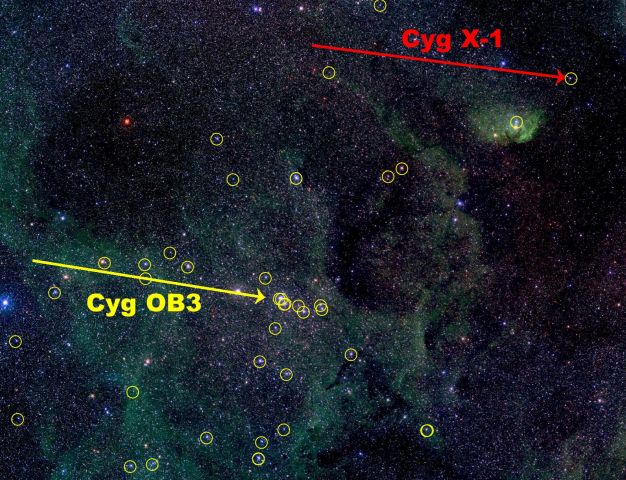
|
Explanation: The formation of a black hole from the collapsing core of a massive star is thought to be heralded by a spectacular supernova explosion. Such an extremely energetic collapse is also a leading explanation for the mysterious cosmic gamma-ray bursts. But researchers now suggest that the Milky Way's most famous black hole, Cygnus X-1, was born when a massive star collapsed -- without any supernova explosion at all. Their dynamical evidence is summarized in this color image of a gorgeous region in Cygnus, showing Cyg X-1 and a cluster of massive stars (yellow circles) known as Cygnus OB3. Arrows compare the measured direction and speed of Cyg X-1 and the average direction and speed of the massive stars of Cyg OB3. The similar motions indicate that Cyg X-1's progenitor star was itself a cluster member and that its path was not altered at all when it became a black hole. In contrast, if Cyg X-1 were born in a violent supernova it would have likely received a fierce kick, changing its course. If not a supernova, could the formation of the Cyg X-1 black hole have produced a dark gamma-ray burst in the Milky Way?
|
January February March April May June July August September October November December |
| ||||||||||||||||||||||||||||||||||||||||||||||||
NASA Web Site Statements, Warnings, and Disclaimers
NASA Official: Jay Norris. Specific rights apply.
A service of: LHEA at NASA / GSFC
& Michigan Tech. U.
Based on Astronomy Picture
Of the Day
Publications with keywords: Cyg X-1 - black hole - supernova - gamma-ray burst
Publications with words: Cyg X-1 - black hole - supernova - gamma-ray burst
See also:
- APOD: 2024 November 24 Á Journey to the Center of the Galaxy
- APOD: 2024 October 1 Á Porphyrion: The Longest Known Black Hole Jets
- APOD: 2024 June 16 Á Animation: Black Hole Destroys Star
- Simulation: Two Black Holes Merge
- The Galaxy, the Jet, and a Famous Black Hole
- APOD: 2024 May 8 Á Visualization: A Black Hole Accretion Disk
- APOD: 2024 May 7 Á Black Hole Accreting with Jet
